AI writing tools are everywhere. From ChatGPT to Jasper, they’ve made content creation faster than ever. But as AI writing becomes mainstream, so does the need to detect it.
Educators want to ensure academic honesty.
Brands want to confirm originality.
Publishers want to protect trust.
Enter AI content detectors—software designed to distinguish human-written from AI-generated text.
But do these detectors really work in 2025? And which ones are worth using?
Let’s test the reality, explore the best tools, and learn how to use them responsibly.
What Is an AI Content Detector?
AI content detectors use language models to analyze a piece of text and determine how likely it was written by AI. They rely on markers like:
- Predictable word patterns
- Repetitive phrasing or syntax
- Low linguistic entropy (too “perfect” structure)
- Sentence probability compared to human writing habits
Modern detectors are powered by transformer-based analysis—some even use the same models that generate AI content (like GPT-4) to detect it.
If you want to improve your AI prompting skills, explore our guide: AI Prompt Writing: How to Get Better Outputs.
Why AI Detection Matters
| Use Case | Who Uses It | Goal |
| Education | Teachers, universities | Verify academic integrity |
| SEO & Marketing | Agencies, freelancers | Maintain originality, avoid AI-content penalties |
| Publishing | Media houses | Preserve trust & author credibility |
| Corporate | HR & training teams | Ensure authentic communication |
In short: AI helps you write; detectors keep you honest.
For rewriting or editing your content into a more human tone, view our detailed guide here: ChatGPT for Paraphrasing & Content Creation.
Best AI Content Detectors in 2025
Below are the most accurate and frequently updated AI detection tools, based on feature sets, accessibility, and testing reliability.
1. Writer.com AI Content Detector

Best for: Marketers & agencies ensuring originality
Specs:
- Free tool (1,500 characters per scan)
- Detects GPT-3.5, GPT-4, and Claude models
- Integrated into Writer’s content suite
- Provides AI probability score
Pros:
- Trusted by major marketing firms
- API access for bulk checking
- Works well for short-form content
Cons:
- Limited free characters
- May misclassify edited AI content
2. GPTZero
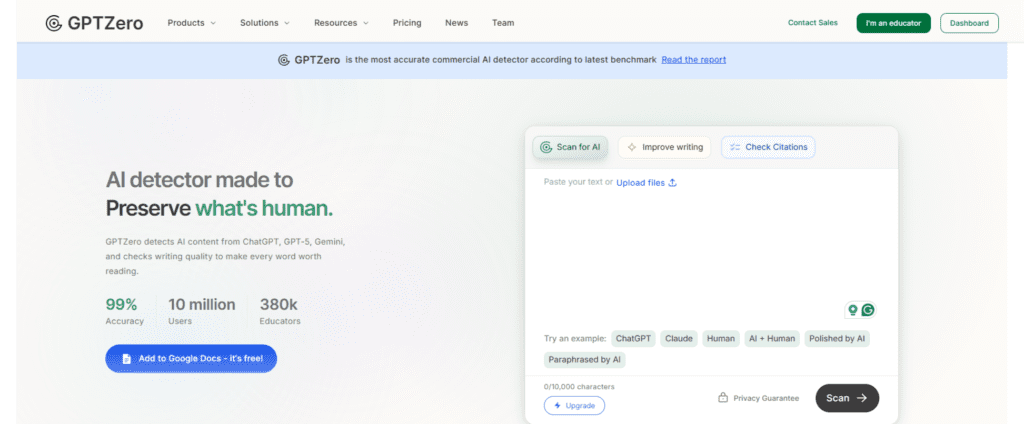
Best for: Academia & research institutions
Specs:
- Developed by Princeton researchers
- Analyzes “burstiness” and “perplexity”
- Supports .docx, .pdf, and plain text uploads
- Enterprise dashboards for educators
Pros:
- Transparent scoring metrics
- Used by schools globally
- Detects subtle AI paraphrasing
Cons:
- Slower scanning for large files
- Less accurate on hybrid human-AI text
3. Originality.ai
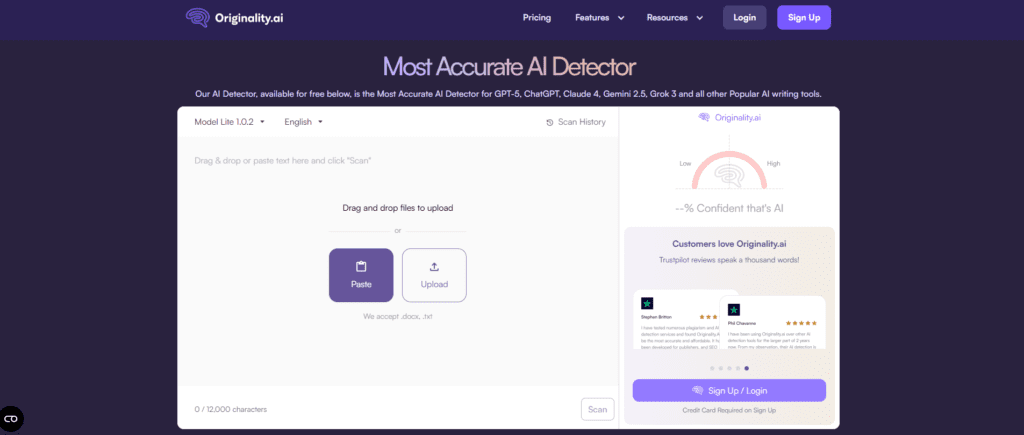
Best for: Professional writers & SEO agencies
Specs:
- Paid tool ($0.01 per 100 words)
- Detects GPT-3.5, GPT-4, Bard, Claude, and paraphrased text
- Includes plagiarism check
- API integration for publishers
Pros:
- Industry-leading accuracy (90%+)
- Combined plagiarism + AI detection
- Regularly updated for new models
Cons:
- Paid only (no free plan)
- May flag AI-assisted rewrites unfairly
To learn more about safely creating AI-assisted blogs, check out: AI Blog Generators — Do They Really Work.
4. Sapling AI Detector
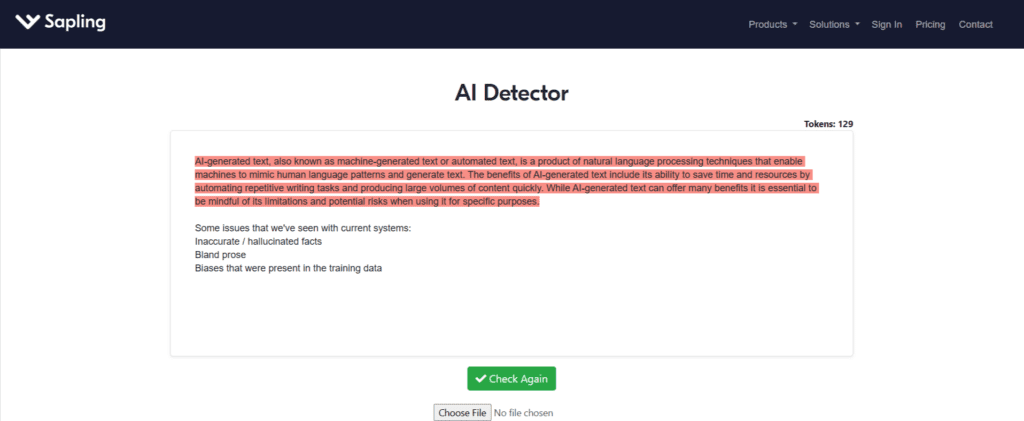
Best for: Businesses checking emails or reports
Specs:
- Free, browser-based
- Detects ChatGPT-style writing patterns
- Integrates with CRMs & Chrome extension
Pros:
- Instant feedback
- Easy for internal corporate use
- Lightweight and fast
Cons:
- Limited insight into model confidence
- Basic reporting interface
5. Copyleaks AI Detector
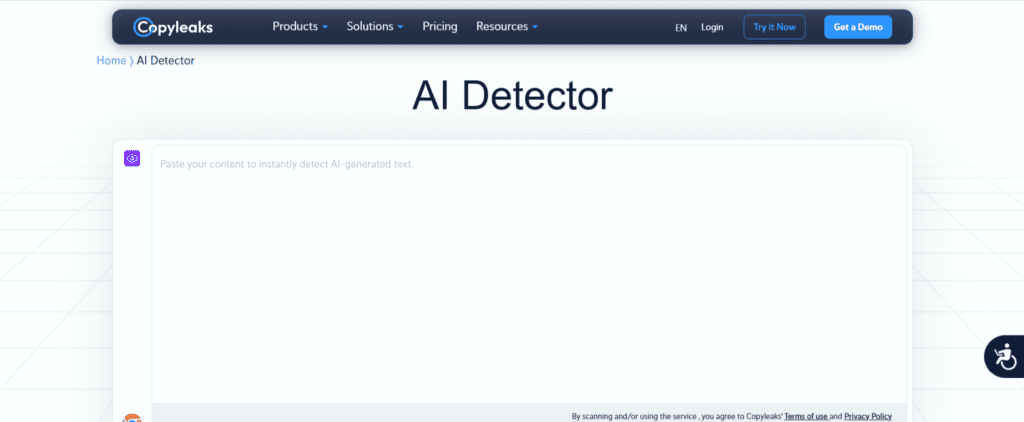
Best for: Enterprises & publishers
Specs:
- Detects GPT-4, Gemini, Claude, and multilingual content
- Includes plagiarism scan + education dashboard
- Chrome extension + LMS integrations
Pros:
- Multi-language support
- Enterprise accuracy
- GDPR compliant
Cons:
- Pricing on request
- Occasional false positives on rephrased text
6. Crossplag AI Detector
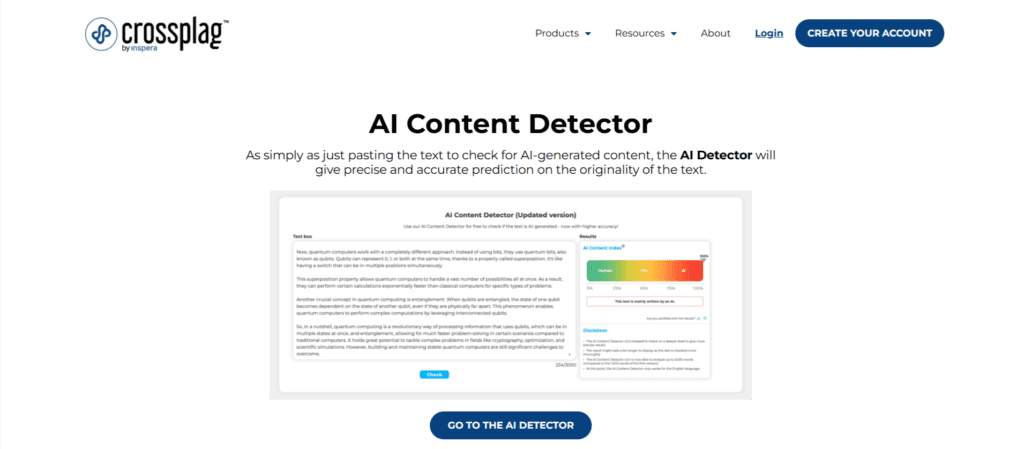
Best for: Universities & research organizations
Specs:
- Based on a hybrid model combining plagiarism + AI pattern analysis
- Detects multi-lingual content
- Visual “AI vs Human” score meter
Pros:
- Simple visual scoring
- Strong for academic documents
- Affordable pricing
Cons:
- Limited to 1,000 words per scan in the free plan
7. Content at Scale AI Detector
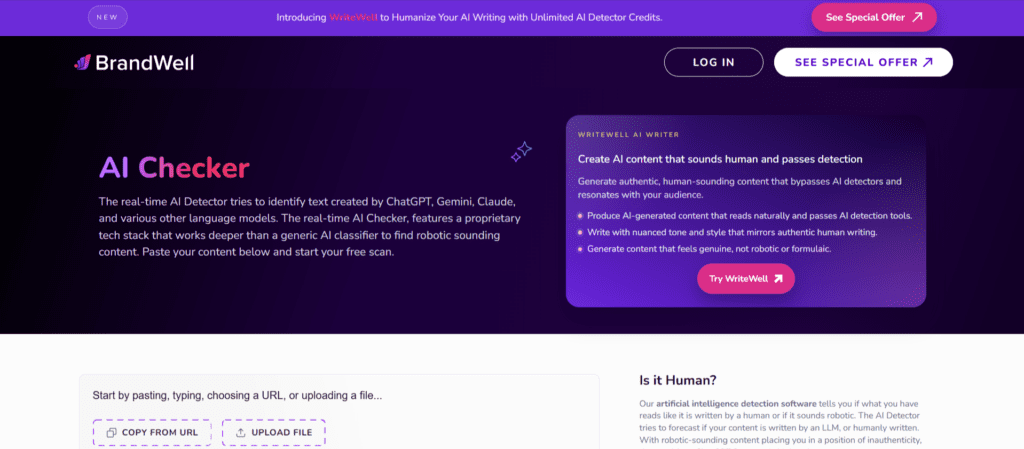
Best for: SEO blogs and agency workflows
Specs:
- Free for up to 2,500 characters
- Built to recognize GPT-3, 3.5, and 4 patterns
- Scores text as “Likely Human,” “Mixed,” or “Likely AI”
Pros:
- Simple interface
- Quick results
- Integrated with their writing platform
Cons:
- Not ideal for academic tone detection
- Limited transparency on the algorithm
8. ZeroGPT
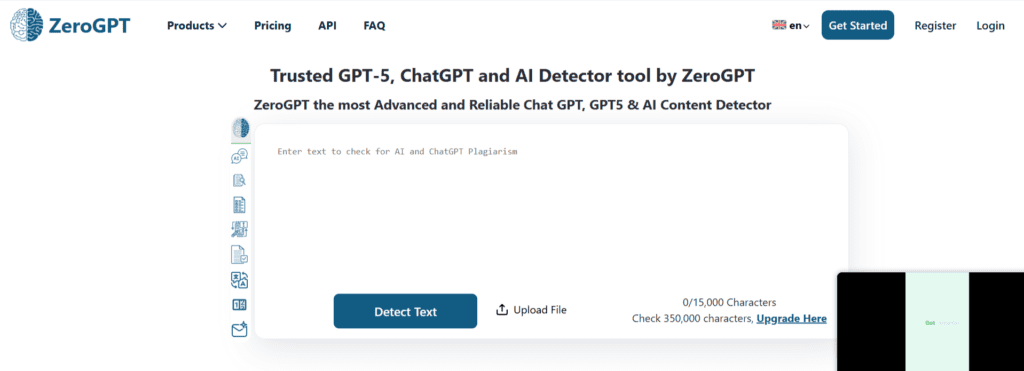
Best for: General writers checking AI percentage
Specs:
- Free AI text checker
- Detects GPT-3, GPT-4, and LLaMA models
- Sentence-by-sentence probability analysis
Pros:
- Free and fast
- Clear probability scores
- Popular for casual use
Cons:
- Occasional over-flagging
- Lacks deep reporting
Accuracy Comparison (2025 Benchmark)
| Detector | Free Plan | Accuracy (Approx.) | Best For |
| Writer.com | Yes | 80–85% | Marketing teams |
| GPTZero | Yes | 75–85% | Education |
| Originality.ai | No | 90%+ | Agencies |
| Copyleaks | Yes (limited) | 85–90% | Publishers |
| Sapling | Yes | 70–80% | Corporate comms |
| Content at Scale | Yes | 75% | SEO blogs |
| ZeroGPT | Yes | 65–75% | General use |
Note: No AI detector is 100% accurate. Even the best systems struggle with heavily edited or hybrid content (AI + human).
How to Improve Detection Accuracy
- Check smaller samples (400–800 words) rather than full posts.
- Avoid uploading formatted HTML — plain text performs better.
- Combine multiple tools — e.g., Writer.com + GPTZero.
- Review flagged text manually before taking action.
- Remember context matters: AI-assisted ≠ fully AI-generated.
Limitations of AI Detectors
- False positives: AI may flag authentic human writing, especially concise or technical pieces.
- Bias toward English: Multilingual detection is still less reliable.
- Rapid model evolution: New AI models outpace detector training.
- Detection fatigue: Over-reliance can hinder creativity.
The key takeaway? AI detectors should inform decisions, not replace human judgment.
Emerging Trends in AI Detection (2025-2026)
- Cross-model detection: Tools like Originality.ai now track multiple LLM signatures simultaneously.
- AI watermarking: OpenAI and Google DeepMind are developing cryptographic watermarks for model outputs.
- Metadata tagging: Some publishing platforms auto-tag AI-assisted content for transparency.
- Context-aware scoring: New detectors analyze tone consistency and the author’s writing style history.
Conclusion
AI content detectors are improving rapidly—but none are perfect.
In 2025, tools like Originality.ai, Writer.com, and Copyleaks will lead the pack for reliable, transparent detection.
For marketers and educators, combining 2–3 detectors and layering manual review is still the best practice.
At Reliqus Marketing, we help agencies and brands maintain authenticity while scaling AI-assisted content safely.
Contact us to learn how to combine AI creation and detection ethically within your content workflow.
FAQs
Q1. Which AI content detector is the most accurate in 2025?
Originality.ai leads the market with over 90% accuracy for GPT-3.5 and GPT-4 text.
Q2. Are free AI detectors reliable?
Free tools like Writer.com and GPTZero work well for quick checks but aren’t 100% reliable.
Q3. Can AI-generated content bypass detectors?
Yes, especially when rewritten, mixed with human edits, or paraphrased using GPT-4.
Q4. Is Google penalizing AI-generated content?
No, Google ranks helpful content—AI-assisted or human—if it meets E-E-A-T and quality standards.
Q5. Should agencies rely only on AI detectors?
No. Always pair detectors with human editing and context understanding for fair evaluation.
